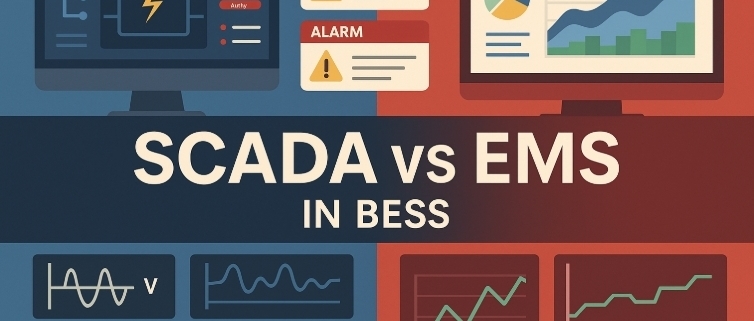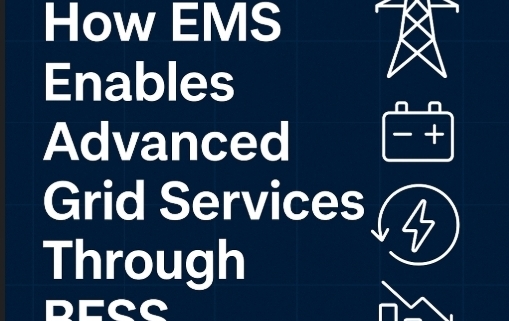SCADA vs EMS in BESS: Understanding the Brain and Nerve System of Energy Storage
SCADA vs EMS in BESS: Battery Energy Storage Systems (BESS) are more than just batteries—they are intelligent ecosystems. At the heart of this intelligence lie two key control systems: SCADA (Supervisory Control and Data Acquisition) and EMS (Energy Management System).
But what’s the difference between them? Why do you need both in your energy storage infrastructure? Let’s break it down.
🔍 What is SCADA in BESS?
✅ Key Functions of SCADA:
- Real-time Monitoring: Tracks voltage, temperature, SOC (State of Charge), power output, and more.
- Data Acquisition: Collects data from sensors, meters, and other field devices.
- Alarm Management: Triggers alerts in case of system faults, safety issues, or performance anomalies.
- Remote Control: Lets operators switch systems ON/OFF or change parameters remotely.
- Visualization: SCADA HMIs (Human-Machine Interfaces) display data visually for easy interpretation.
⚙️ What is EMS in BESS?
EMS is the strategic brain of the energy storage system. While SCADA controls how things operate, EMS decides what should be done to maximize efficiency, economics, and reliability.
✅ Key Functions of EMS:
- Energy Flow Optimization: Determines how and when to charge/discharge the battery.
- Peak Shaving & Load Shifting: Reduces grid demand during peak hours.
- Forecasting: Uses weather and load predictions for solar/wind integration.
- Grid Compliance: Ensures system follows utility rules and demand response signals.
- Cost Management: Optimizes energy usage based on real-time prices or tariffs.
EMS works above the SCADA layer, making strategic decisions based on data collected by SCADA and other sources.
🔁 Key Differences: SCADA vs EMS in BESS
| Feature | SCADA | EMS |
|---|---|---|
| Primary Role | Operational monitoring & control | Strategic energy optimization |
| Scope | Device & hardware level | System-wide & market interaction |
| Real-time Control | Yes | No (uses planning-based control) |
| Forecasting | No | Yes |
| Alarm & Event Handling | Yes | Limited (depends on integration) |
| Grid Interaction | Minimal | Full (based on market, grid, or DSO signals) |
| Visualization | SCADA HMI/GUI | Dashboards/Reports |
🧠 Real-World Comparison: How SCADA & EMS Work Together
Imagine a utility-scale solar-plus-storage project:
➤ SCADA’s Role:
- Monitors PV inverter voltage, battery temperature, current flows.
- Flags errors in PCS (Power Conversion System) and triggers shutdowns if needed.
- Logs all sensor data every second.
➤ EMS’s Role:
- Analyzes day-ahead pricing forecasts and predicts solar production.
- Decides to charge batteries at noon and discharge at 6 PM to maximize ROI.
- Communicates with SCADA to execute commands.
Together, EMS and SCADA form a closed-loop intelligence system—SCADA watches, EMS decides.
🌐 Different Use Cases (EMS vs SCADA in BESS)
🔋 Residential ESS
- SCADA is usually embedded at low levels.
- EMS often comes pre-configured or in cloud-based form for load shifting and solar self-use.
🏭 Commercial & Industrial ESS
- SCADA monitors multiple assets: batteries, PV, diesel gensets.
- EMS optimizes cost-saving strategies across multiple sites.
⚡ Utility-Scale BESS
- SCADA integrates with substation automation and DNP3/IEC 61850 protocols.
- EMS participates in energy markets, frequency response, and ancillary services.
📈 Why You Need Both
Some may think EMS alone is enough, but it’s not. Without SCADA, the EMS is blind. Without EMS, the SCADA is mute.
✅ SCADA ensures the system runs safely.
✅ EMS ensures it runs profitably.
You need both for your BESS to be intelligent, safe, and profitable.
❓ FAQ: SCADA vs EMS in BESS
Q1. Can SCADA and EMS be integrated into one platform?
Yes. Many vendors offer combined platforms or modular systems where EMS sits on top of SCADA.
Q2. Is EMS cloud-based and SCADA local?
Generally, yes. SCADA operates locally for fast response, while EMS can be local or cloud-based for broader optimization.
Q3. Which one is more expensive?
EMS often costs more due to its software intelligence, licensing, and integration needs.
Q4. Which is more important for safety?
SCADA is crucial for safety and reliability. EMS focuses more on economic performance.
📌 Final Thoughts: Build a Smarter BESS with SCADA and EMS
Understanding the SCADA vs EMS in BESS distinction is not just academic—it has real business and technical consequences. If you want your Battery Energy Storage System to be both safe and smart, you need both systems.
Understanding their roles and differences is crucial for:
- System integrators
- Project developers
- Energy consultants
- Facility managers
- And anyone involved in the deployment of BESS
Whether you’re building a microgrid or managing utility-scale storage, make sure your BESS includes both a robust SCADA and an intelligent EMS.
Looking for help integrating SCADA and EMS in your energy project? Reach out to a qualified consultant who understands both layers of the stack and can optimize your BESS from the ground up.



